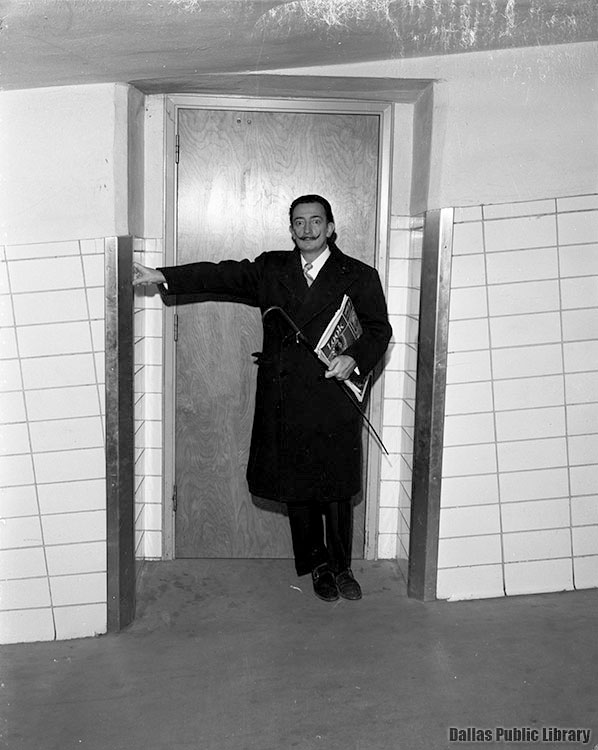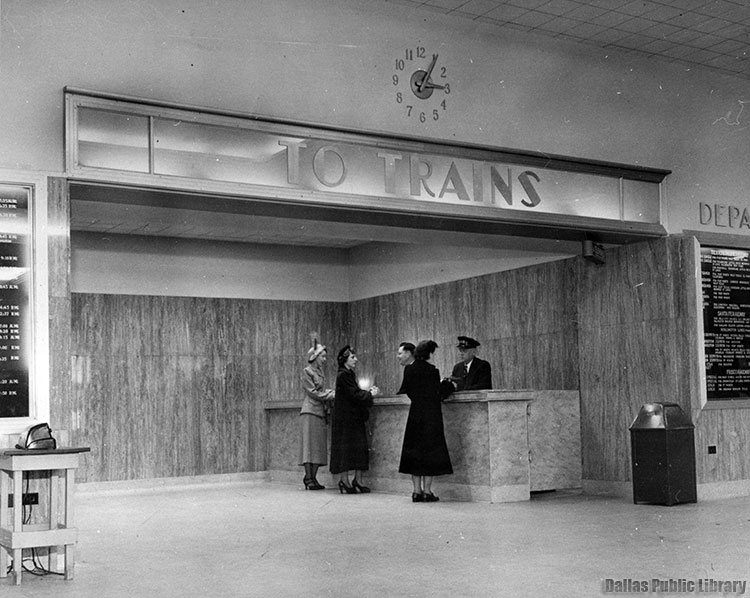In February 1952, Salvdaor Dalí was in Dallas to lecture at SMU’s McFarlin Auditorium, where the extravagantly mustachioed Spanish surrealist observed that “Texans dream in Technicolor, whereas New Yorkers dream only in black and white.” According to the Dallas Morning News account, Dalí also revealed the key to his new art (“it’s mysticism”) and speculated in characteristically humble fashion that his “first name, Salvador, may imply that it is his role to be ‘savior’ of modern art.”
There is at least one extant photo of Dalí’s visit to Dallas, a particularly fitting image of the man “who made the drooping watch famous,” as the paper put it. It was taken at Union Station. There the artist found himself drawn to a slanted door. “A Dalí-ian door,” he said—exclaimed, in the words of the photographer—and posed for a photo.

That image is among a batch of 70 historical photos of Union Station that were recently digitized by the library’s Dallas History & Archives Division and published in the library’s online catalog, a treasure trove of snapshots of the city’s longtime transit center. Today Union Station, despite the DART and TRE lines right outside, can feel a little sleepy. That wasn’t always the case. When the building went up in 1916 to serve as a hub for the many rails crossing North Texas, it was intended to serve something like a dozen railways. As trains prevailed as a mode of cross-country transportation, the nearly 80 trains a day that stopped at Union Station moved soldiers, baseball players, celebrities, politicians. It often had to be the most exciting place in Dallas.
There’s Jerry Lewis, pretending to take a nap on a pile of luggage while Dean Martin looks on. Dwight Eisenhower, gripping hands after a campaign rally. In 1918, soldiers standing on the platform outside and waiting on their train. In 1952, soldiers sleeping on benches and chairs inside. The women with the bouquets of flowers by the car parked on Houston Street, 1927. Baseball fans welcoming the minor league Dallas Eagles.
These photos, and many more like them, are part of the library’s efforts to create “digital surrogates” for its vast collection of historical photos, says Brandon Murray in the Dallas History and Archives Division. That’s to give the images a life beyond the limits of their physical 4×5 negatives, and to prevent any additional wear-and-tear from handling by the college students writing papers, the researchers working on books, and the curious Dallasites wanting to see what their neighborhood looked like 50, 60, or even 100 years ago. It’s also to make the photos more easily accessible to a bigger audience, which dovetails nicely with the work of the Dallas Public Library—and libraries across the country—to reinvent themselves and reach more people in the internet age. (Did you know the central library’s history and archives division is on a beautiful, recently renovated seventh floor with a 1623 copy of William Shakespeare’s First Folio and one of the original broadsides of the Declaration of Independence?)

“It’s really about people knowing that we have an archive,” Murray says. “We have this way to preserve photos that will further our knowledge of Texas and Dallas history.”
Preserving photos digitally is not easy, or cheap. (Consider donating to the Friends of the Dallas Public Library and specifying that the money should go toward the History and Archives division’s digitization projects. They could use a specialized scanning machine for unwieldy old manuscripts, and some part-time help never hurts.) Of the roughly 1.5 million historical photos and negatives in the library’s archives, only about 6,000 images are online. The selection of Union Station photos is arranged around a subject, a place. That organizing principle applies to these historical images of Dallas neighborhoods, and of historic residences.
Often the online photo exhibits come from private collections. You may have seen photos from the Marion Butts Collection on the web. Butts, a black newspaperman for the Dallas Express who died in 2002, photographed African American life in North Texas for decades. Librarians are now working on digitizing the Hayes Collection, which includes the photo of Dalí above and several other Union Station images. The collection is chock-full of photos taken by Denny Hayes and his sons, often shot on contract for the Dallas Times Herald.
But you don’t have to be a professional photographer for your work to be of historical value. The library’s image archives are full of amateur work, and the history and archives department is always willing to look at possible additions to its collection. Rummage around in your attic. The photos don’t even have to be that old.
“A photo taken yesterday will have possible historical significance years from now,” Murray says. Those photos of your family visiting the West End in 1997 might mean something to a future researcher writing about Dallas in the ’90s. They could be just as valuable as the images of the city’s growing skyline, its activists and leaders, its changing neighborhoods, its day-to-day struggles and triumphs.
It’s all history. Much of it’s been—being—photographed. And, one day not too distant from now, it should be a library card and a click away.





